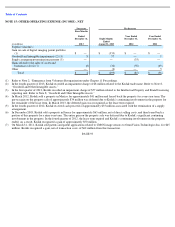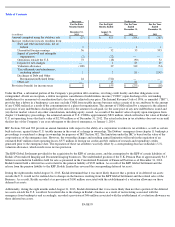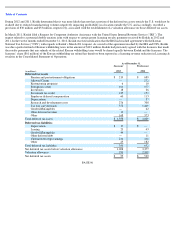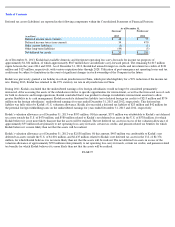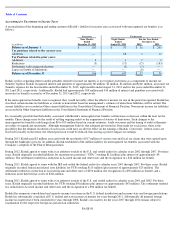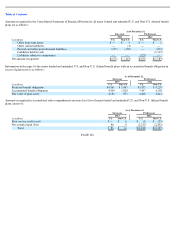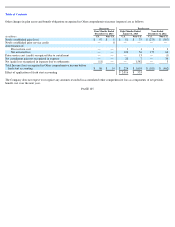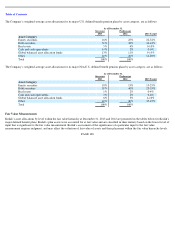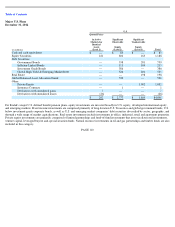Kodak 2013 Annual Report Download - page 108
Download and view the complete annual report
Please find page 108 of the 2013 Kodak annual report below. You can navigate through the pages in the report by either clicking on the pages listed below, or by using the keyword search tool below to find specific information within the annual report.
Table of Contents
As a result of these initiatives, severance payments were paid during periods through 2013 since, in many instances, the employees whose
positions were eliminated can elect or are required to receive their payments over an extended period of time. In addition, certain exit costs,
such as long-term lease payments, will continue beyond 2013.
2013 Activity
Restructuring actions taken in 2013 were initiated to reduce Kodak’s cost structure as part of its commitment to drive sustainable profitability.
Actions included manufacturing capacity reductions in the U.S. and the U.K., the continued wind down of the consumer inkjet printer business,
a workforce reduction in France, and various targeted reductions in service, sales, and other administrative functions.
As a result of these actions, for the four months ended December 31, 2013 Kodak recorded $17 million of charges reported as Restructuring
costs and other in the accompanying Consolidated Statement of Operations. For the eight months ended August 31, 2013, Kodak recorded $52
million of charges, including $4 million for accelerated depreciation and $2 million for inventory write-downs which were reported in Cost of
sales, $43 million reported as Restructuring costs and other and $3 million which were reported as Discontinued operations in the
accompanying Consolidated Statement of Operations, The severance and exit costs reserves require the outlay of cash, while long-lived asset
impairments, accelerated depreciation and inventory write-downs represent non-cash items.
The 2013 severance costs related to the elimination of approximately 825 positions, including approximately 500 manufacturing/service, 300
administrative and 25 research and development positions. The geographic composition of these positions included approximately 375 in the
U.S. and Canada, and 450 throughout the rest of the world.
The charges of $17 million recorded for the four months ended December 31, 2013 included $1 million applicable to the Digital Printing and
Enterprise Segment, $8 million applicable to the Graphics, Entertainment and Commercial Films Segment, and $8 million that was applicable
to manufacturing, research and development, and administrative functions. The charges of $52 million recorded for the eight months ended
August 31, 2013 included $5 million applicable to the Digital Printing and Enterprise Segment, $22 million applicable to the Graphics,
Entertainment and Commercial Films Segment, and $22 million that was applicable to manufacturing, research and development, and
administrative functions and $3 million applicable to discontinued operations.
As a result of these initiatives, severance payments will be paid during periods through 2014 since, in many instances, the employees whose
positions were eliminated can elect or are required to receive their payments over an extended period of time. In addition, certain exit costs,
such as long-term lease payments, will be paid over periods throughout 2014 and beyond.
NOTE 19: RETIREMENT PLANS
Substantially all U.S. employees are covered by a noncontributory defined benefit plan, the Kodak Retirement Income Plan (“KRIP”), which is
funded by the Company contributions to an irrevocable trust fund. The funding policy for KRIP is to contribute amounts sufficient to meet
minimum funding requirements as determined by employee benefit and tax laws plus any additional amounts the Company determines to be
appropriate. Assets in the trust fund are held for the sole benefit of participating employees and retirees. They are composed of corporate equity
and debt securities, U.S. government securities, partnership investments, interests in pooled funds, commodities, real estate, and various types
of interest rate, foreign currency, debt, and equity market financial instruments.
For U.S. employees hired prior to March 1999 KRIP’
s benefits are generally based on a formula recognizing length of service and final average
earnings. KRIP includes a separate cash balance formula for all U.S. employees hired after February 1999 (the “Cash Balance Plan”). All U.S.
employees hired prior to that date were granted the option to choose the traditional KRIP plan or the Cash Balance Plan. Written elections were
made by employees in 1999, and were effective January 1, 2000. The Cash Balance Plan credits employees’ hypothetical accounts with an
amount equal to 4% of their pay, plus interest based on the 30-year Treasury bond rate. In addition, for employees participating in the Cash
Balance Plan and the Company’s defined contribution plan, the Savings and Investment Plan (“SIP”), the Company matches dollar-for-dollar
on the first 1% contributed to SIP and $.50 for each dollar on the next 4% contributed. The Company’s contributions to SIP were $6 million
and $8 million for 2013 and 2012, respectively.
The Company also sponsored unfunded non-qualified defined benefit plans for certain U.S. employees, primarily executives. The pre-petition
obligations associated with these plans were discharged upon emergence pursuant to the terms of the Plan (see Retirees’ Settlement under Note
2, “Emergence from Voluntary Reorganization under Chapter 11 Proceedings”). The plans were discontinued upon emergence.
PAGE 101



